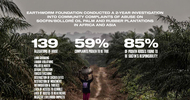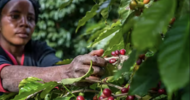Gambella eyes palm cultivation in wake of commercial farming exodus
By Ashenafi Endale
Ethiopia’s hopes of ushering in a new era of commercial farming ventures rested in large part on the shoulders of the Gambella Regional State. Recent years have seen hundreds of investors granted licenses and credit to establish commercial farms in the southwestern corner of the country, but little has come from the efforts.
The past couple of years have been especially tough, with security concerns and bureaucratic hurdles pushing out dozens of foreign investors who had their eyes on growing cotton, soy beans, mung beans, and other crops in Gambella.
The region also continues to struggle with the burden of hosting hundreds of thousands of South Sudanese refugees, some of whom have been implicated in looting commercial farms.
However, the prospects of establishing palm tree plantations in the region are offering new hopes and a chance at redemption.
The Reporter’s Ashenafi Endale spoke with Aemro Mekuria, director for investment research and promotion at the Gambella Investment Commission, to get an understanding of the potentials of palm cultivation, the region’s security conditions, issues with investors and their creditors, and the prospects of other investment ventures in the pipeline. EXCERPTS:
The Reporter: We have spoken to a number of Ethiopian investors who say they are preparing to embark on commercial palm tree farming ventures in Gambella. What can you tell us about them? Studies have long indicated that Gambella is well suited for palm tree cultivation but the region is yet to see any tangible progress. Why is that?
Aemro Mekuria: A few companies are preparing to begin commercial palm plantations in Gambella. Previously, Karuturi, an Indian company, and other investors tried to but they’ve [since] left. Currently, one Ethiopian company has leased 25,000 hectares.
There is a 100 hectare palm tree plantation in Godere Woreda, near Tepi. An Ethiopian company bought that place and is making final preparations to expand into a large-scale operation. Some of these palm tree plantation investors are also on the way to establishing their own airstrips near the farms. They are also engaged in growing other crops such as mung beans.
These investors have taken time to begin, but they are in the final stages [of preparations]. It took time because the investors had to study palm tree seeds from various places, study the environment in Gambella, and select the fitting seed variety.
The method of multiplying the seeds is also a determinant. Tissue culture is often used. These investors brought in the top palm seed experts from Malaysia and other countries. They have been conducting studies in Gambella. Finding the proper variety is crucial, and it has taken time and effort.
What is the potential of palm tree cultivation in Gambella?
Science changes with time. Under the old science of palm tree tissue culture, a palm tree bears fruit within seven years. But the latest technology has shortened this time to less than four years. So now, there are palm tree varieties that can bear fruit between three to four years after seedling. The production time has halved.
Palm trees can now be cultivated in lowland areas, where before they preferred highlands. Now, they can be grown at 300 meters above sea level. All these improvements in palm tree varieties were created using GMOs and other technologies.
Gambella is between rainy and semi-dry. It is not dry. But at the seedling stage, the palm trees need to be irrigated. So these investors in the pipeline are also working on installing their own irrigation systems. Once the palm tree is mature, it can survive on rain, without irrigation. A
All of Gambella is conducive for palm tree cultivation.
Previously, the Indian investors used to cultivate palm trees at around 400 meters above sea level. Now, the Ethiopian investors are planting at 600 meters above sea level.
Why did Karuturi leave?
Karuturi had initially embarked on the cultivation of several crops. It also planted palm tree seedlings at 300 meters above sea level in Gambella. But the farms failed and Karuturi left. The company bought the palm seedlings from elsewhere, and the seedlings stayed in the nursery site for close to two years. By then, the palm trees should have been on a proper farm nearing the time to bear fruit. At the time, the owner of Karuturi died. So it was his son, Ram Karuturi, who was handling the investments. Ram Karuturi could not handle the commercial farming investments in Gambella with the same level of commitment and performance as his father.
What other investment projects, outside of palm trees, are underway in Gambella?
Two factors have been affecting investment in Gambella. The first is the security issues. Security has been a concern especially following the incident involving OLF-Shane in Gambella. The other factor is issues related to the suspension of credit by the Development Bank of Ethiopia [DBE].
Prior to these developments, there was a high level of activity in commercial investments for cotton, sesame, soy beans, mung beans, peanut, maize, and other crops. There were several cotton investors. Saudi Star was working on commercial rice farming in Gambella. There was also a commercial banana farming investment project in Godere Woreda.
But since those incidents, the number of investors has declined. Currently, there are investors only in maize and sorghum. There are also mung bean investors. More and more investors prefer to cultivate maize because it fetches a higher price in the market.
Is security still a concern for investors?
There are no security concerns in Gambella now. The Ethiopian National Defense Force [ENDF] has established bases in Gambella and is securing peace and stability. ENDF is providing a security guarantee in every area where there were concerns. Gambella is safe now.
What happened to the large plots previously granted to DBE-financed commercial farms? There was a dispute between the regional administration and the DBE. Has it been resolved?
It is not fully resolved. A large amount of land in Gambella was given to hundreds of commercial farming investors. But many of the investors abandoned their projects and left without repaying the loans they took from the DBE. The regional government wants to take back the lands from DBE and re-allocate them to other investors. But the DBE wants to reassign the lands to other potential investors, to recover the unpaid loans it provided. This is the bone of contention. The DBE is currently doing well, in terms of providing the lands to fresh investors. It has also lowered the loan interests for the fresh investors.
What is the guarantee that these fresh commercial farming investors will not fail like the previous ones?
After taking the lessons, the DBE is extending loans only to commercial farming investors who build their own irrigation infrastructure. Farmers and investors who are working on rain-based agriculture are not considered investors or eligible for bank loans now.
GMO cotton farming was introduced in Gambella a few years back. How is the progress now?
It has slowed down due to challenges related to the multiplication of the GMO cotton seed. Initially, the GMO cotton seeds were supplied from agricultural research centers outside Gambella, mainly from the Afar region. Bringing the seed from another place and cultivating it here is difficult. The seed must be produced here in Gambella, using tissue culture in greenhouses. If this can be done, I hope it will improve. So far, there is only the F1 generation; no F2.
How is the investment activity in the mining sector in Gambella?
There are no large-scale mining investment projects in Gambella. Most of them are artisanal and small scale. Only two large-scale mining investors are currently in the pipeline. These two are licensed by the federal government.
There is a proliferation of contraband in gold mining across Ethiopia. How is the trend in Gambella?
If there is gold, there is contraband and conflict. They are inseparable.
There are also reports indicating security issues related to refugees from South Sudan. Some accuse the refugees of claiming land illegally, and looting cattle and agricultural machinery from commercial farming projects. Are such incidents taking place?
Whenever there is instability in Gambella, which is often triggered by OLF-Shane, the refugees run away from their camps. There are several refugee camps in Gambella. Then these refugees might get involved in some acts. Especially when the commercial crop farms are ripe, the refugees try to illegally harvest the crops. They take ripe maize, mung beans, cotton and others. But they do so when there is conflict or instability in the region. The refugees use conflict as cover. Sometimes, crops might be completely wiped out while still on the farm.
What are the other challenges hampering investment in Gambella?
One of the major challenges is our own bureaucracy. There are also challenges in finding and attracting the proper and right investors. There is a problem in bringing in investors who have the financial, technological and technical capacity, and who have practical experience in investments in such a peripheral part of the country where infrastructure is difficult.
Most of our bureaucracy lacks the investment proportion aspect. I do not think we are doing enough regarding exposing our immense potential to investors. Meanwhile, there is a capacity issue in finding and bringing in the right investor.
When an investment project fails in one region, it damages the image of that region, and discourages other investors from coming to that region. I think we have to reverse this. If we manage to bring two or three big, effective commercial farming investors to Gambella, then I am sure all other investors will come. Just a few successful investment projects can change the image from the past. Farmers in Gambella are no different from traditional farmers elsewhere. They depend on rain. We need a few successful projects, and then the image of Gambella’s investment history will change dramatically.
There were around twelve big foreign investment projects in Gambella involved in commercial farming, including soya bean, rice, cotton, sesame and others. One of them was Karuturi. I do not understand why these twelve big foreign investors left Gambella. Except for security, I do not think there is another major challenge that could force them out.
I still do not comprehend what factor discouraged those investors. Of course, the support on the ground might not be the same as the expectations these foreign investors had when they came to Ethiopia.
Who do you think failed to provide support to the foreign investors; the federal government or Gambella regional government?
The federal government basically gives licenses to foreign investors. But the support packages are provided both by the federal and local governments, down to the kebele. There was a big gap between the investors’ expectation and the actual support on the ground.













